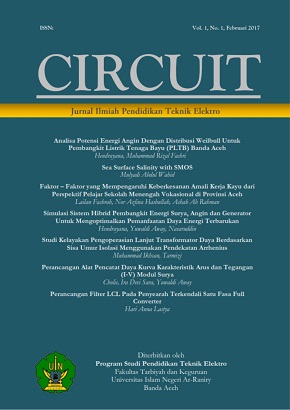Simulasi Perancangan Solar Tracker Pada Pembangkit Listrik Wind-Solar
DOI:
https://doi.org/10.22373/crc.v5i2.8555Keywords:
Solar Cell, Wind Solar, Solar TrackerAbstract
The research was conducted to explain how to design a simulation of Solar tracker on Wind-Solar hybrid technology. The simulation were carried out with proteus software simulation. Solar tracker has four LDR sensors and an Arduino Uno Microcontroller which assist the Solar tracker to estimating position of the sun to use a servo motor for solar cell movement. For the result, When the upper light intensity (LDR 1 and LDR 2) is greater than the bottom (LDR 3 and LDR 4), solar cell will move upwards, and vice versa. When the light intensity of the left (LDR 1 and LDR 3) is greater than the right (LDR 2 and LDR 4), solar cell will move to the left, and vice versa. From the research, it could concluded that Solar Tracker can be applied to Wind-Solar technology solar cells
References
Adijarto, Waskita. 2020. “Pengertian Sistem Embedded.” 2020. https://kv.stei.itb.ac.id/display/EL4121T2020/Pengertian+Sistem+Embedded.
Andasto, Tatyantoro. 2020. “Simulasi Kontrol Motor Servo Menggunakan Arduino.” 2020. https://www.youtube.com/watch?v=comDRVHUKYA&t=327s.
Hasan, Ola Dwi Sandra, Ridho Hantoro, and Gunawan Nugroho. 2013. “Studi Eksperimental Vertical Axis Winmd Turbine Tipe Savonius Dengan Variasi Jumlah Fin Pada Sudu.” Jurnal Teknik POMITS 2 (2): 350–55.
Kho, Dickson. n.d. “Pengertian Sel Surya (Solar Cell) Dan Prinsip Kerjanya.” https://teknikelektronika.com/pengertian-sel-surya-solar-cell-prinsip-kerja-sel-surya/.
Latief, Karwati Putu. 2019. “Gerak Semu Matahari, Penyebab Cuaca Panas Ekstrim Di Indonesia.” 2019. https://www.harapanrakyat.com/2019/10/gerak-semu-matahari/.
Oby, Zamisyak. 2020. “Penjelasan Bagian Dan Pin Arduino Uno.” http://kelasarduino.com/penjelasan-bagian-dan-pin-arduino-uno/.
Rasyid, Abdurrahman. 2019. “Sensor Cahaya LDR (Light Dependent Resistor).” 2019.
Wang, Ting. 2015. “The Design of Charging Controller in Wind-Photovoltaic Hybrid Power Generation System,” no. Cmes: 402–4.
A. Ndiaye, C. M. F. Kébé, V. Sambou, and P. A. Ndiaye, “Development of a Charge Controller Dedicated to the Small Wind Turbine System,” Energy Environ. Res., vol. 4, no. 3, pp. 68–77, 2014, doi: 10.5539/eer.v4n3p68.
M. K. Johari, M. A. A. Jalil, M. Faizal, and M. Shariff, “Comparison of horizontal axis wind turbine ( HAWT ) and vertical axis wind turbine ( VAWT ),” vol. 74, no. October, pp. 74–80, 2018, doi: 10.14419/ijet.v7i4.13.21333.
M. Alsayid, A. Alramadhan, M. Alwesmi, M. Almansoor, and A. Alnaseer, “Department of Mechanical Engineering Senior Design Project Report Helical Wind Turbine,” 2016.
P. K. Das, M. C. Lavanya, K. Boopathi, and G. Giridhar, “WIND WIND - SOLAR HYBRID HYBRID ENERGY ENERGY PRODUCTION PRODUCTION ANALYSIS ANALYSIS REPORT,” 2016.
T. Abrar, Q. Mary, M. Shabbir, S. Salman, and O. Siddiqui, “Wind & solar renewable energy,” no. June 2016, 2010, doi: 10.13140/RG.2.1.2863.3203.
S. Anglistia, “PROTOTYPE SISTEM PELACAKAN SINAR MATAHARI PADA SISTEM,” 2018.
N. Publikasi et al., “PROTOTYPE KENDALI OTOMATIS PENERANGAN TAMAN,” 2018.
N. N. Hamidah, “Solar Tracker,” 2017. https://create.arduino.cc/projecthub/nafianh/solar-tracker-a71f8e?ref=user&ref_id=248225&offset=0
Riouch, T, A Alamery, and C Nichita. 2015. “Control of Battery Energy Storage System for Wind Turbine Based on DFIG during Symmetrical Grid Fault Control of Battery Energy Storage System for Wind Turbine Based on DFIG during Symmetrical Grid Fault.” In , 13–18.
Downloads
Published
Issue
Section
License
Authors who publish in CIRCUIT: Jurnal Ilmiah Pendidikan Teknik Elektro agree to the following terms:
- Authors retain copyright and grant the journal right of first publication with the work licensed under a Creative Commons Attribution-ShareAlike 4.0 International License (CC BY-SA 4.0) that allows others to share and adapt the work with an acknowledgement of the authorship and initial publication in this journal
- Authors are able to enter into separate, additional contractual arrangements for the non-exclusive distribution of the journal's published version of the work (e.g., post it to an institutional repository or publish it in a book), with an acknowledgment of its initial publication in this journal.
- Authors are permitted and encouraged to post their work online (e.g., in institutional repositories or on their website) prior to and during the submission process, as it can lead to productive exchanges, as well as earlier and greater citation of published work. (See The Effect of Open Acces)

